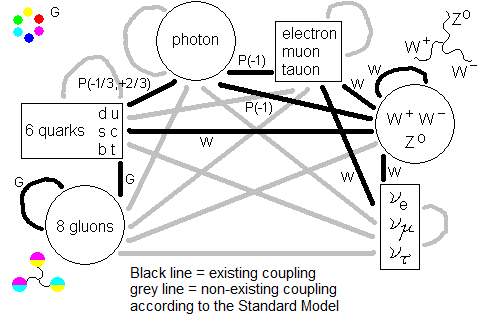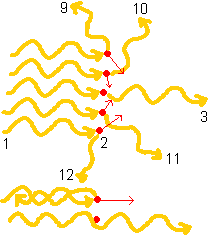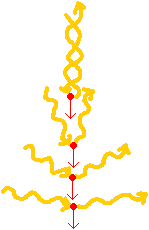Possible pasts joining the superposition
When a photon hits an electron, the electron can be pushed aside according to the Compton scattering rules.
The photon that just passes by without reacting still has one definite past. One just elongates the line along which it is travelling in backward direction, a straight line in a curved spacetime, and there you are. But the ph 2-3 is new. On itself it doesn't have a fixed past. When it emerges suddenly quite a number of possibilities for its past join the superposition. The past of ph 2-3 (up until now that is ph 1-2) will be in a superposition of all possible directions it could have come from (among which is the ph 1-3 passage through the electron). Is there anything that forces us to enter one of those possibilities ph 4-2, ph 5-2, ph 3-2, ph 6-2, ph 7-2 or one of the directions in between? (see fig.5)

fig.5: All possible pasts of ph 2-3.
Yes, the electron. Compton scattering rules demand the directions of the photon and the electron after scattering both start at 2 (the original electron's place) and then to lie in the same plane. Measuring the electron's state will make us enter one of these possibilities. If the photon comes from by example direction 4 the electron is pushed downward-left in the figure. The photon then had its origin somewhere on the photon's worldline in direction 4. If direction 7 eventually has been chosen, the electron is pushed upward-left in the figure and the photon had been born somewhere on the worldline of direction 7.
In the next page we make a trip to massive particles joining the superposition and gravitation spoiling the picture, before returning to the possible pasts and futures of the reaction ph 1-2-3.
A trip to massive particles and gravitation spoiling the superposition
No matter what possibility is chosen, we agreed to live in a universe that behaves normally: in a newly chosen past the photon has to originate somewhere. One can elongate its path backwards along its track through the curved spacetime of the universe. But when galaxy after galaxy has been left aside and the photon gains energy caused by the backward elapse of expansion of the universe, and still no particle is met to serve as its origin, it finally will meet the big bang. Then the big bang has to sustain its existence. Which might be a problem: the nowadays remnants of the big bang are about 3K degrees mainly. Our photon would hardly be permitted to exceed that energy, which is about 1 cm wavelength. The further away the photon's origin, the more energetic that origin must be to sustain its energy in our local environment, due to the expansion of the universe. A different origin more nearby is more likely. An object, a particle that is not present in all possibilities.
This holds only if the photon and the electron after 2 in the figure bear no knowledge of the rest of the universe and that they wouldn't notice the change of the photon's past by referring to data stored somehow-somewhere in their own local environment. Is it possible for the photon-electron-ensemble after 2 not to know the rest of the universe?
We restrict to our local environment around the electron. We are a few moments before 2. The electron had been present in our local environment at rest as it was there all the time. So yes, we have knowledge of the electron all the time. The photon, still part of the outside, is raging toward us with the maximum speed there is in this universe. No, we had no previous knowledge of its existence. No, by no means another particle, either real or virtual, had been able to reach us before the photon with knowledge of its purposes. So yes, we are able not to know anything about the rushing-in photon. Then all possibilities join the superposition: every possible photon from every possible direction; no photon at all; a gluon (since that moves at lightspeed too); and all possible massless neutrino's (if existing); and - but ho! Is that all possible?
Gluons don't react with electrons. And neutrino's only do by means of a W+, W- or Z-null particle. Then one of these heavy particles had to appear in our local environment first. Ok, a W+, W- or Z-null particle can appear, but it is unlikely.
Other electrons or electron-like particles do react with our electron by means of real or virtual photons. A quark idem. Those photons are faster than the massive particles they originate from. So electrons, electron-like particles and quarks can only serve as a new place to be born for photons reaching us.

The Standard Model
There is a legal
way to get rid of all massive particles in the superposition. Every massive particle has a small gravitational field around it. According to gr it warps spacetime around it a very little bit and a tiny part of that very little bit reaches onto our local environment. This can cause an effect in its phase enough to wrest a choice from the superposition. The electron will be forced to enter the possibility of the specific massive particle. The particle is moving toward us and the particle's gravitational field strength felt by the electron increases with smaller distance. Gravitational influence of a mass moves towards us with the speed of light. Before any massive particle could have reached us its warp of spacetime had already forced us to enter its world. We are not allowed to remain ignorant of the approach of a massive particle. There can't be a superposition of approaching massive particles and we may skip them from the superposition.
That is, we don't know yet how gravitation and QED fit together. The reasoning so far might be illegal. To prevent overload we just skip the massive particles and hope this is a right decision.
Allright, what possibilities do contribute to the superposition?
1) No particle at all,
2) All photons of all energy, all phases (let's take the phase at the moment of impact), all spins (+1 or -1) and coming from all directions towards event 2,
3) A sudden W+, W- or Z-null appearance at the moment a massless neutrino arrives,
We skip the quarks, all electron-like particles and all massive neutrino's. We already skipped the gluons.
Possibility 1, no photon at all. We already had no photon all the time, before event 2. This is stable and maintains the existence of the electron at 2. It looks not special - but wait! We can superpose a passing by photon going through the electron without reacting with it. We superpose such possibilities with every photon that does react.
Possibility 2. Every superposed world is a valid world on its own. The world of the incoming and outgoing photon and the electron, obeys the conservation laws. It fits the Compton scattering rules. But we made the choice the transition between the possible worlds not to obey the conservation laws.
All the superposed possibilities of the outside world may differ a lot, its energy-distribution and all its accompanying gravitational fields, as long as they fit with our knowledge of the outside present in our local environment.
The world may end just outside our visible horizon, but we no longer assume so. Instead just outside our visible horizon we assume a sea of possibilities. A herd of worlds in superposition, among which the nothing is just one of them. And each of those worlds has a different future. And a different past.
The electron after 2 and the reemitted photon are correlated particles. Measuring ph 2-3 however reveals nothing about the past of the photon or the electron, as long as ph 2-3 is our designated end-state in all possibilities. It will leave the superposition intact. A measurement of the electron before 2 is of no use either since we choose the electron standing still as starting state in every possibility. It will leave the superposition intact too. A measurement of the photon before 2 - well, we are investigating the possibilities for a photon being acted on without being absorbed by an electric charge. Let's not take for granted we can measure the photon here without disturbing it.
Possibility 3. (Not yet implemented.)
![]() O
O
![]()
![]() NVESTIGATE
NVESTIGATE
Possible pasts and futures joining the superposition: the past can be changed
Provided the photon does hit the electron, ph 1-2 will seldom hit the electron head-on. All possible futures of ph 1-2 are given in fig.6.

fig.5: All possible pasts of ph 2-3 |

fig.6: All possible futures of ph 1-2 |
All shown electrons move in different directions. No two of the 2-photon-reactions (1 photon in and 1 photon out) share an associated electron of identical impulse - needed to superpose reactions with identical out-photons (but with a different in-photon). No aligned in- and out-photon have same energy - needed if we want to assemble them to one reaction and then superpose with a passing-by not-reacting photon. Except for ph 1-2 and ph 2-3 which have been chosen as our starting condition to suit perfectly to each other as if the reaction hadn't taken place
.
The incoming photons in fig.5 like ph 4-2 are more energetic than the aligning outgoing photons in fig.6 - ph 2-11 in this case. (Let's take ph 4-2 and ph 2-11 to be aligned, although the pictures are not really decisive about that.) The incoming photons have to provide ph 2-3's energy plus the electron's kinetic energy. All outgoing photons have to share ph 1-2's energy with the electron. Except for the reaction ph 1-2-3 again.
![]()
It is time to loose our designated future. As well as our past we already have forgotten. We only know our local environment. All we know ends at its borders, all possible universes surround it in superposition: the sea of possibilities. To it all possible pasts can lead. From it all possible futures can sprout.
Take event 2 as local environment. In fact, take the electron at event 2 - we can't deny its existence there. Before event 2 the electron is standing still. After event 2 it can have every state of motion. Let's start from a specific electron state after 2 (in stead of a specific incoming-photon state).

fig.7: The incoming photon may come from any of the upper-left directions. The outgoing photon suits to states of the electron and the incoming photon, according to the Compton scattering rules.
Do all these possibilities superpose? That depends. There is no knowledge stored in our local environment neither about the photon's past nor about its future. We only enter one specific future if we measure somehow the outgoing photon, by example by a measuring sphere around it made of photodetecting material. A past and a future must fit to each other according to the Compton rules. Within this limits the past is free to choose by choosing a future. Until then all possible futures of the photon superpose and with it all appropriate pasts.
If there is open sky allowing this, the photons of two different futures may have originated at two different galaxies. Let's call them galaxy A and galaxy B. If the photon turned out to come from galaxy A then galaxy B might even not exist, leaving only empty space there instead.
Several influences might spoil this picture. In general there is gravitation. If something of the gravitational influence of one galaxy reaches onto our local environment its existence is written in the spacetime of our local environment. Then we have knowledge about the galaxy. It cannot disappear when our photon turned to originate in another galaxy.
Especially decisive too is light from galaxy A and B that reaches our local environment and by a sufficiently strong telescope reveals its existence on a photograph stored in some database long ago. We just can see the galaxies then when we check the databank.
And when the light is there we assume the gravitational influence is there too, enough to spoil a superposition.
Maybe we should not directly refer to galaxies. One single hydrogen atom in some state at the right place, instead of the distant galaxies, is enough. By allowing any state of velocity to the atom we can get from it a photon of every desired wavelength (Doppler-effect). Let's call them atom A and atom B. We assume there is little chance any influence of such a single atom at that distance will enter our local environment. Except for our photon, of course.